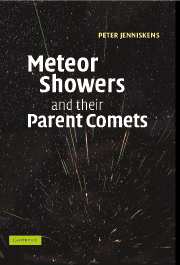Book contents
- Frontmatter
- Dedication
- Contents
- Preface
- Acknowledgements
- Part I Introduction
- Part II Parent bodies
- Part III Young streams from water vapor drag
- Part IV Young streams from comet fragmentation
- Part V Old streams and sporadic meteoroids
- Part VI Impact and relevance of meteor showers
- 32 Impact!
- 33 Meteor showers on other planets
- 34 Meteors and the origin of life
- Appendix
- Tables
- Index
- Units and constants
33 - Meteor showers on other planets
from Part VI - Impact and relevance of meteor showers
Published online by Cambridge University Press: 05 July 2015
- Frontmatter
- Dedication
- Contents
- Preface
- Acknowledgements
- Part I Introduction
- Part II Parent bodies
- Part III Young streams from water vapor drag
- Part IV Young streams from comet fragmentation
- Part V Old streams and sporadic meteoroids
- Part VI Impact and relevance of meteor showers
- 32 Impact!
- 33 Meteor showers on other planets
- 34 Meteors and the origin of life
- Appendix
- Tables
- Index
- Units and constants
Summary
Some day in the future, we will perhaps travel to Mars or Venus to watch a particularly nice meteor shower. Super fast meteoroids entering at 85 km/s, or meteors in slow-motion at 5 km/s. Until that time, remote observing and robotic missions may glimpse these meteors, or in the absence of an atmosphere, the impact flashes. They will probe the large-grain dust environment away from Earth's orbit and sample comets not encountered by Earth. And they probe the ablation process in atmospheres more like that of the early Earth. A call to include meteor surveys on space landers has been made.
Meteoroid impacts may also be traced from the neutral atom debris layers (and their associated narrow ionospheric layers of electrons) that they leave behind high in the atmosphere. Theoretical models predict that such layers exist at Venus, Mars, Jupiter, Saturn, Neptune, and Saturn's moon Titan. Even the sparse atmospheres of Triton and Pluto may on occasion be lit up by slow meteors.
33.1 Meteor showers on the Moon
Our Moon does not have a permanent atmosphere, but impact flashes have been observed. Meteoroids hit the surface continuously. They add meteoric metals to the Moon's surface and are responsible for the release of the sodium atoms that cause our Moon's sodium atmosphere.
In 1939, Lincoln LaPaz estimated that 5 kg sized boulders hitting the Moon would produce visible flashes at a rate of 10 a year. Unconfirmed reports of impact flashes included that of F. H. Thornton, who detected a point of light on the floor of Plato in October of 1945. In August of 1948, A. J. Woodward saw a flash “like a bright sparkle of frost” that lasted three seconds. He described it as having “the appearance of an object striking the moon.” Another case was that of H. P. Wilkins, who observed a 1 s point of light in the crater Gassendi in May of 1951. Coordinated attempts by the Association of Lunar and Planetary Observers (ALPO) to observe such impacts, a project coordinated by Robert M. Adams from 1955 to 1965, never succeeded in obtaining simultaneous, independent observations of “Lunar transient phenomena.”
- Type
- Chapter
- Information
- Meteor Showers and their Parent Comets , pp. 561 - 574Publisher: Cambridge University PressPrint publication year: 2006



